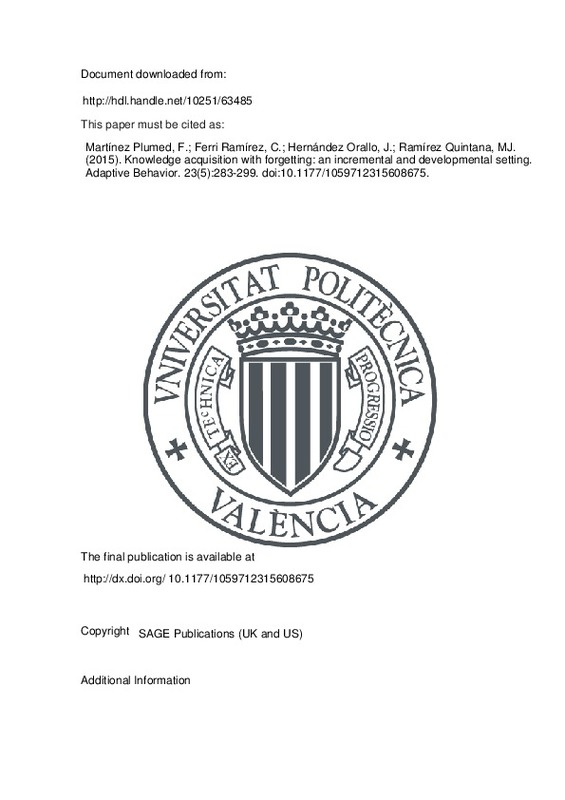Alnajjar, F., Bin Mohd Zin, I., & Murase, K. (2009). A Hierarchical Autonomous Robot Controller for Learning and Memory: Adaptation in a Dynamic Environment. Adaptive Behavior, 17(3), 179-196. doi:10.1177/1059712309105814
Ans, B., & Rousset, S. (1997). Avoiding catastrophic forgetting by coupling two reverberating neural networks. Comptes Rendus de l’Académie des Sciences - Series III - Sciences de la Vie, 320(12), 989-997. doi:10.1016/s0764-4469(97)82472-9
Brin, S., & Page, L. (1998). The anatomy of a large-scale hypertextual Web search engine. Computer Networks and ISDN Systems, 30(1-7), 107-117. doi:10.1016/s0169-7552(98)00110-x
[+]
Alnajjar, F., Bin Mohd Zin, I., & Murase, K. (2009). A Hierarchical Autonomous Robot Controller for Learning and Memory: Adaptation in a Dynamic Environment. Adaptive Behavior, 17(3), 179-196. doi:10.1177/1059712309105814
Ans, B., & Rousset, S. (1997). Avoiding catastrophic forgetting by coupling two reverberating neural networks. Comptes Rendus de l’Académie des Sciences - Series III - Sciences de la Vie, 320(12), 989-997. doi:10.1016/s0764-4469(97)82472-9
Brin, S., & Page, L. (1998). The anatomy of a large-scale hypertextual Web search engine. Computer Networks and ISDN Systems, 30(1-7), 107-117. doi:10.1016/s0169-7552(98)00110-x
Carpenter, G. A., & Grossberg, S. (1988). The ART of adaptive pattern recognition by a self-organizing neural network. Computer, 21(3), 77-88. doi:10.1109/2.33
Della Sala, S. (2010). Forgetting. doi:10.4324/9780203851647
Eiter, T., & Wang, K. (2008). Semantic forgetting in answer set programming. Artificial Intelligence, 172(14), 1644-1672. doi:10.1016/j.artint.2008.05.002
Erbas, M. D., Winfield, A. F., & Bull, L. (2013). Embodied imitation-enhanced reinforcement learning in multi-agent systems. Adaptive Behavior, 22(1), 31-50. doi:10.1177/1059712313500503
Ferri-Ramírez, C., Hernández-Orallo, J., & Ramírez-Quintana, M. J. (2001). Incremental Learning of Functional Logic Programs. Lecture Notes in Computer Science, 233-247. doi:10.1007/3-540-44716-4_15
FRENCH, R. M. (1997). Pseudo-recurrent Connectionist Networks: An Approach to the «Sensitivity-Stability» Dilemma. Connection Science, 9(4), 353-380. doi:10.1080/095400997116595
Gama, J., Žliobaitė, I., Bifet, A., Pechenizkiy, M., & Bouchachia, A. (2014). A survey on concept drift adaptation. ACM Computing Surveys, 46(4), 1-37. doi:10.1145/2523813
Grossberg, S. (2013). Adaptive Resonance Theory: How a brain learns to consciously attend, learn, and recognize a changing world. Neural Networks, 37, 1-47. doi:10.1016/j.neunet.2012.09.017
Hernandez-Orallo, J. (2000). Constructive reinforcement learning. International Journal of Intelligent Systems, 15(3), 241-264. doi:10.1002/(sici)1098-111x(200003)15:3<241::aid-int6>3.0.co;2-z
Hernández-Orallo, J., & García-Varea, I. (2000). Foundations of Science, 5(2), 185-207. doi:10.1023/a:1011350914776
Hourdakis, E., & Trahanias, P. (2012). Computational modeling of observational learning inspired by the cortical underpinnings of human primates. Adaptive Behavior, 20(4), 237-256. doi:10.1177/1059712312445902
Kitzelmann, E. (2010). Inductive Programming: A Survey of Program Synthesis Techniques. Lecture Notes in Computer Science, 50-73. doi:10.1007/978-3-642-11931-6_3
Kleinberg, J. M. (1999). Authoritative sources in a hyperlinked environment. Journal of the ACM, 46(5), 604-632. doi:10.1145/324133.324140
Lang, J., Liberatore, P., & Marquis, P. (2003). Propositional Independence - Formula-Variable Independence and
Forgetting. Journal of Artificial Intelligence Research, 18, 391-443. doi:10.1613/jair.1113
Lang, J., & Marquis, P. (2010). Reasoning under inconsistency: A forgetting-based approach. Artificial Intelligence, 174(12-13), 799-823. doi:10.1016/j.artint.2010.04.023
Lempel, R., & Moran, S. (2000). The stochastic approach for link-structure analysis (SALSA) and the TKC effect. Computer Networks, 33(1-6), 387-401. doi:10.1016/s1389-1286(00)00034-7
Leu, G., Curtis, N. J., & Abbass, H. A. (2013). Society of Mind cognitive agent architecture applied to drivers adapting in a traffic context. Adaptive Behavior, 22(2), 123-145. doi:10.1177/1059712313509652
Li, M., & Vitányi, P. (2008). An Introduction to Kolmogorov Complexity and Its Applications. Texts in Computer Science. doi:10.1007/978-0-387-49820-1
Martínez-Plumed, F., Ferri, C., Hernández-Orallo, J., & Ramírez-Quintana, M. J. (2013). Learning with Configurable Operators and RL-Based Heuristics. Lecture Notes in Computer Science, 1-16. doi:10.1007/978-3-642-37382-4_1
Muggleton, S. (1995). Inverse entailment and progol. New Generation Computing, 13(3-4), 245-286. doi:10.1007/bf03037227
Muggleton, S., Bain, M., Hayes-Michie, J., & Michie, D. (1989). An Experimental Comparison of Human and Machine Learning Formalisms. Proceedings of the Sixth International Workshop on Machine Learning, 113-118. doi:10.1016/b978-1-55860-036-2.50037-0
Muggleton, S., & de Raedt, L. (1994). Inductive Logic Programming: Theory and methods. The Journal of Logic Programming, 19-20, 629-679. doi:10.1016/0743-1066(94)90035-3
Quiroga, R. Q. (2012). Concept cells: the building blocks of declarative memory functions. Nature Reviews Neuroscience, 13(8), 587-597. doi:10.1038/nrn3251
Raducanu, B., & Vitrià, J. (2008). Learning to learn: From smart machines to intelligent machines. Pattern Recognition Letters, 29(8), 1024-1032. doi:10.1016/j.patrec.2007.09.003
Rissanen, J. (1999). Hypothesis Selection and Testing by the MDL Principle. The Computer Journal, 42(4), 260-269. doi:10.1093/comjnl/42.4.260
Shannon, C. E. (1949). Communication Theory of Secrecy Systems*. Bell System Technical Journal, 28(4), 656-715. doi:10.1002/j.1538-7305.1949.tb00928.x
Shastri, L. (2001). Biological Grounding of Recruitment Learning and Vicinal Algorithms in Long-Term Potentiation. Lecture Notes in Computer Science, 348-367. doi:10.1007/3-540-44597-8_26
Su, K., Sattar, A., Lv, G., & Zhang, Y. (2009). Variable Forgetting in Reasoning about Knowledge. Journal of Artificial Intelligence Research, 35, 677-716. doi:10.1613/jair.2750
Wallace, C. S., & Boulton, D. M. (1968). An Information Measure for Classification. The Computer Journal, 11(2), 185-194. doi:10.1093/comjnl/11.2.185
Wallace, C. S. (1999). Refinements of MDL and MML Coding. The Computer Journal, 42(4), 330-337. doi:10.1093/comjnl/42.4.330
Wang, Z., Wang, K., Topor, R., & Pan, J. Z. (2010). Forgetting for knowledge bases in DL-Lite. Annals of Mathematics and Artificial Intelligence, 58(1-2), 117-151. doi:10.1007/s10472-010-9187-9
Wixted, J. T. (2004). The Psychology and Neuroscience of Forgetting. Annual Review of Psychology, 55(1), 235-269. doi:10.1146/annurev.psych.55.090902.141555
Wood, R., Baxter, P., & Belpaeme, T. (2011). A review of long-term memory in natural and synthetic systems. Adaptive Behavior, 20(2), 81-103. doi:10.1177/1059712311421219
Zhang, Y., & Foo, N. Y. (2006). Solving logic program conflict through strong and weak forgettings. Artificial Intelligence, 170(8-9), 739-778. doi:10.1016/j.artint.2006.02.002
Zhang, Y., & Zhou, Y. (2009). Knowledge forgetting: Properties and applications. Artificial Intelligence, 173(16-17), 1525-1537. doi:10.1016/j.artint.2009.07.005
[-]







![[Cerrado]](/themes/UPV/images/candado.png)


